Ali Gholami1,2, Mohammad Karimian3, Behzad Badakhsh4, Feizollah Mansouri5, Mohamadreza Kafashian6, Ali Khorshidi7, Behrouz Soltany8,2, Somayeh Mahdikhani9, Milad Borji10,11, Asma Tarjoman10,11, Lida Nouri11
1-Assistant Professor of Anesthesiology, Department of Anesthesiology;
2-Student Research Committee,
5-Professor of Infectious Disease, Infectious Diseases Department;
8-MSc Nursing, Department of Nursing, Faculty of Nursing and Midwifery, Kermanshah University of Medical Science, Kermanshah, IR Iran
3-Assistant Professor of Vascular Surgery;
4-Assistant Professor of Internal Medicine;
6-Associate Professor of Physiology, Department of Physiology;
7-Associate Professor of Epidemiology, School of Medicine, Psychosocial Injuries Research Center;
10-Student Research Committee;
11-Zoonotic Disease Research Center;
11- Assistant Professor of Anesthesiology, Department of Anesthesiology, Ilam University of Medical Sciences, Ilam, IR Iran
9-PhD Nursing Student, Università degli Studi "La Sapienza" di Roma, Public Health and Infectious Diseases, Undergraduate, (Italy)
Correspondence: Dr Lida Nouri, Assistant Professor of Anesthesiology, Department of Anesthesiology, Ilam University of Medical Sciences, Ilam, IR Iran.
Tell: +98-9183404704, E-mail: lidanouri2016@gmail.com
Received: 15 March 2020, Reviewed: 5 April 2020, Accepted: 6 April 2020
ABSTRACT
Background and Objectives: Pain assessment is very important in these patients, but no comprehensive systematic reviews / meta-analyses (SRs/MAs) have been performed so far. For this reason, this study was performed to determine the prevalence of pain in patients with Covid-19 in the world by SR/MA method.
Methodology: The researchers collected English language articles in which COVID-19 was confirmed and all SRs/MAs and case reports articles were excluded. Search was carried on at SCOPUS®, PubMed® / MEDLINE®, Web of Science®, Science Direct® and Google Scholar's search engine. To extract the data the checklist contained general information about articles, e.g. authors’ names, year of publication, number of patients, country, journal’s name, and specific information, e.g. prevalence and percentage of ‘sore throat’, ‘abdominal pain’, ‘chest pain’, ‘headache’ and ‘myalgia’.
Results: According to the findings, 326 articles were extracted in the initial search, 218 articles of these were classified as duplicate articles because of the frequency in their authors, magazines and sample size, and were excluded. Also, by reviewing the title, abstract and complete files of articles, 73 articles were excluded as being non-relevant. Out of 35 remaining articles 2 were SRs/MAs in the field of COVID-19 by Iranian authors, and were also excluded. In the remaining 33 articles included in this SR/MA study, the sample size was 3781 patients.
Regarding the prevalence of pain in patients, prevalence rate of abdominal pain was 0.02% (95% CI: 0.01, 0.04), headache 10% 95% CI: 0.10 (0.08, 0.12) and myalgia was 18% 95% CI: 0.18 (0.14, 0.23), chest pain was 4% (95% CI: 0.04 (0.01, 0.06), Sore throat was 12% (95% CI: 0.12 (0.08, 0.15).
Conclusion: The results of this study can serve as important criteria to be considered for screening as well as identifying suspected cases of COVID-19. These can also be helpful in formulating the guidelines for the periodic physical evaluation and for clinical management of COVID-19 patients.
Key words: COVID-19; Pain, Coronavirus; Systematic review; Meta-analysis
Citation: Badakhsh B, Mansouri F, Gholami A, Karimian M, Kafashian M, Khorshidi A, Soltany B, Mahdikhani S, Borji M, Tarjoman A, Nouri L. Prevalence of different pain patterns in patients with COVID-19: A systematic review and meta-analysis. Anaesth. pain intensive care. 2020;24(2):141-150
DOI: https://doi.org/10.35975/apic.v24i2.1252
INTRODUCTION
A significant population of the world has been affected by infectious diseases which have led to a decline in the quality of life and caused the death of these patients.1,2 These days COVID-19 is one of the most dangerous infectious diseases affecting the whole world.3-6 According to various studies that have been conducted in this field, symptoms of this disease may include fever, cough, nausea and/or vomiting, loss of sense of smell and taste, runny nose, fatigue and pain. The patients might also experience various types of pain, including sore throat, abdominal pain, chest pain, headache and myalgia.5,7-9
Pain is one of the variables affecting health status that brings the patient to a hospital and helps the physician to early diagnosis of the disease.10-12 Considering, that the disease is a newfound illness, the presence of pain may not be taken seriously or might be mistaken to be originating due to other illnesses. Therefore, identifying clinical symptoms in this disease is very important and needs to be investigated and documented.13-15
OBJECTIVES
Pain assessment is very important in these patients, but no comprehensive SR/MA studies have been performed so far. For this reason, this study was performed to determine the prevalence of pain in patients with COVID-19 in the world by SR/MA method.
METHODOLOGY
1. Protocol
Researchers conducted a SR/MA type of study to determine the prevalence of pain in patients with COVID-19 according to the SR/MA statement (PRISMA) check list.16
2. Inclusion and exclusion criteria
The researchers collected English language articles in which COVID-19 disease was confirmed and all SRs/MAs and case reports were excluded.
3. Information sources and search strategy
Search was carried on at SCOPUS®, PubMed® / MEDLINE®, Web of Science®, Science Direct® and Google Scholar's search engines. Key words used for search included COVID-19, Novel coronavirus, SARS-CoV-2, Wuhan coronavirus, Novel coronavirus 2019, Wuhan pneumonia, 2019 nCoV and pain or pain related terms including Sore throat, Abdominal pain, Chest pain, Headache and Myalgia.
4. Study selection
In the early searches, articles were reviewed for title and abstract by MB and AT, then full texts and references of articles that met the inclusion criteria of these article were studied and according to the existing checklist, required information was extracted. Duplicate articles or those containing incomplete information were excluded. After the search results finalized, articles extracted were reviewed and approved by a third researcher of the AG Study Team.
5. Data collection process and data items
To extract the data a tabulated form was used containing general information of articles (author's name, year of publication, number of patients, country, journal’s name) and specific information (prevalence and percentage of Sore throat, Abdominal pain, Chest pain, Headache, Myalgia) (Table 1).
Data analysis:
Data were analyzed using Stata software.
RESULTS
According to the findings, 326 articles were extracted in the initial search, 218 of these were classified as duplicated articles, because of the multiple appearance of their author names, magazines and sample size. Also, by reviewing the title, abstract and complete file of 73 articles were excluded being non-relevant. The left over 35 articles were again analyzed and 2 Iranian SRs/MAs in the field of COVID-19, were also excluded (Figure 1).
In the 33 articles included in this SR/MA study, the sample size was 3781 patients (Table 1). Regarding the prevalence of pain in patients, the prevalence of abdominal pain was 0.02% (95% CI: 0.01, 0.04), the prevalence of headache was 10% (95% CI: 0.10 (0.08, 0.12), myalgia 18% (95% CI : 0.18 (0.14, 0.23), chest pain was 4% (95% CI : 0.04 (0.01, 0.06) and sore throat was 12% (95% CI : 0.12 (0.08, 0.15) (Figures 2-6).
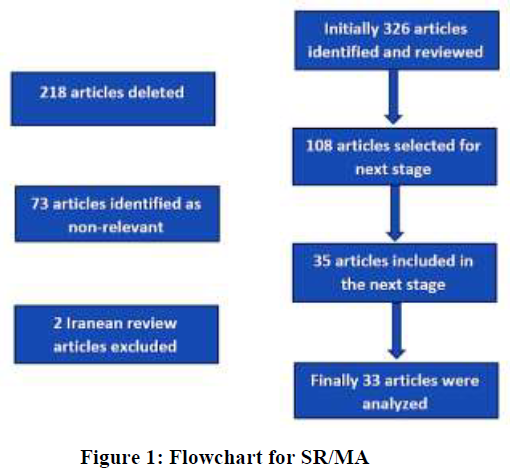
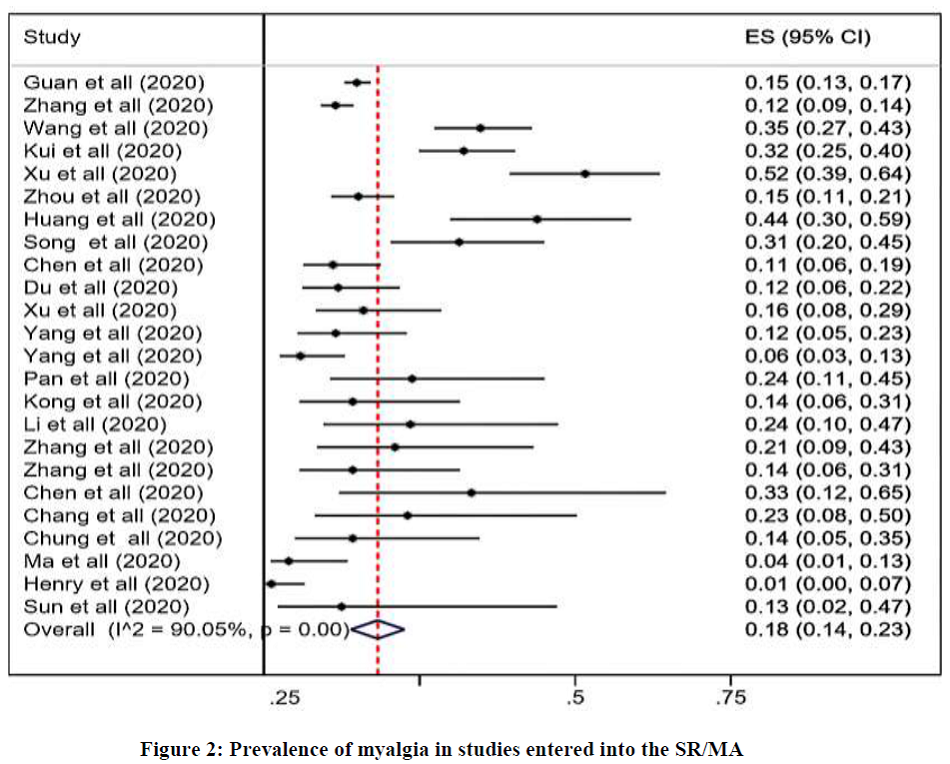
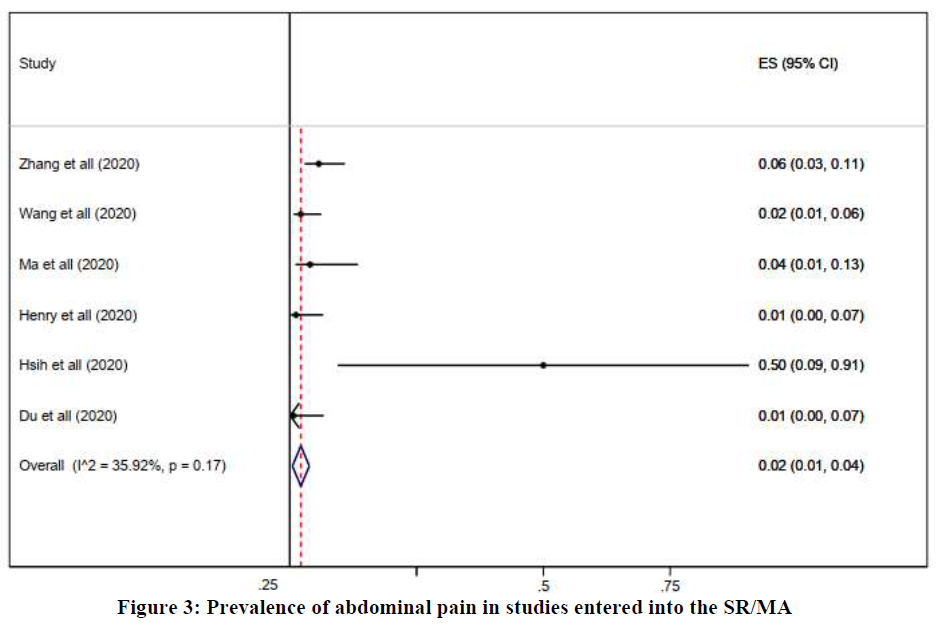
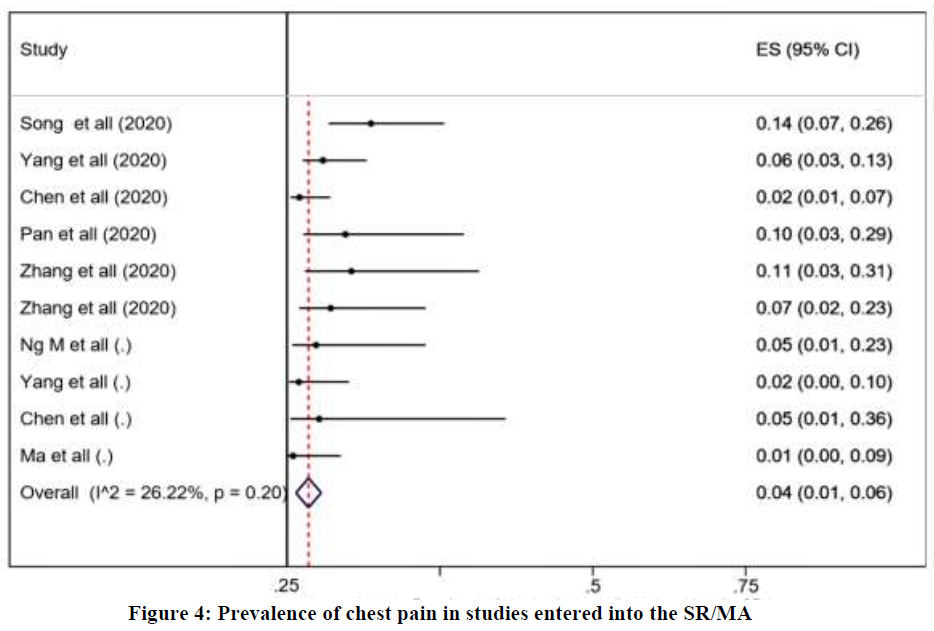
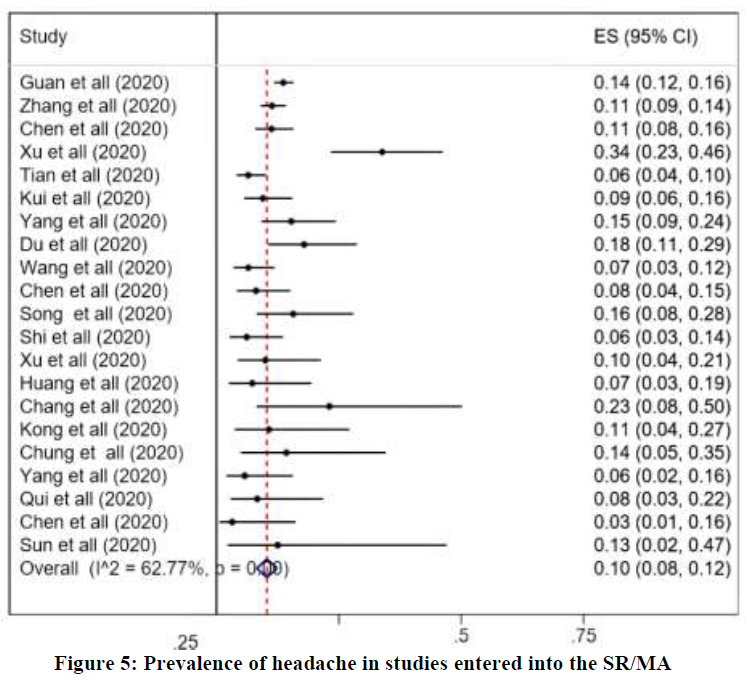
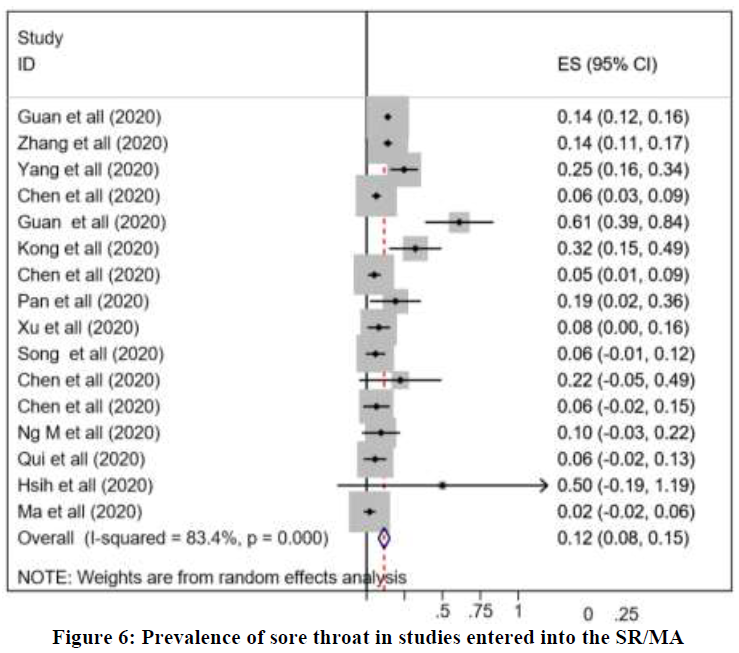
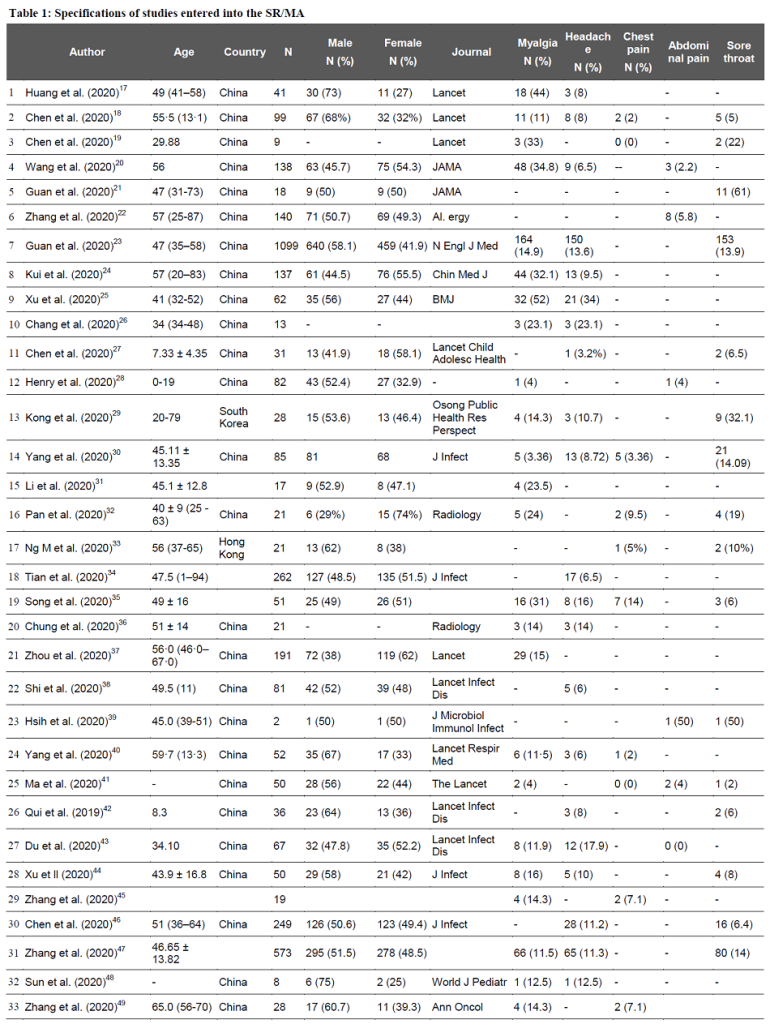
DISCUSSION
Patients with COVID-19, experience a wide range of symptoms including fever, chills, nausea, vomiting, diarrhea, coughing and runny nose.50,51 Pain is another symptom of these patients which in this study has been investigated specifically. This SRs/MAs study investigated pain in 33 articles in which, for the first time in the world, the pain of patients with COVID-19 was evaluated. In the SRs/MAs study published by Nasiri et al, the prevalence of Myalgia in 17 articles was 34.7 (26.0-44.4), headache prevalence in 12 articles was 11.1 (7.7-15.7) and sore throat was 14.5 (10.6-19.5)52. While in this study, the prevalence of Myalgia in 28 analyzed articles was 18% (95% CI : 0.18 (0.14, 0.23) ، Headache prevalence in 21 articles was equal 10% (95% CI : 0.10 (0.08, 0.12) and the prevalence of sore throat with analyze of 16 articles was 12% (95% CI : 0.12 (0.08, 0.15). It seems that regard to more articles have entered SRs/MAs phase and larger sample size, this study has been able to provide more accurate information.
This study investigated the specificity of pain as an important variable in patients' health status which is the innovation of this study. One of the disadvantages of this study is the lack of evaluation of pain status based on the demographic characteristics of the patients. For this reason, it is suggested that by updating articles on clinical symptoms and according to types of pain in patients with COVID-19, in future studies analyze accomplish according to demographic characteristics of patients and underlying diseases.
CONCLUSION
The results of this study can serve as an important criterion in evaluation of patients' health status also consider for screening as well as identifying suspected cases of COVID-19.
Acknowledgment: Student Research Committee, Kermanshah University of Medical Sciences, Kermanshah, Iran (Grant Number: 3009965)
Conflict of interest: The authors have no conflicts of interest to disclose.
Author contributions:
AG, LLN BB: Manuscript writing
MK, FM: Editing
MK, AK: Analysed
BS, MB, AT : Literature search
SM : Translation
REFERENCES
1-Assistant Professor of Anesthesiology, Department of Anesthesiology;
2-Student Research Committee,
5-Professor of Infectious Disease, Infectious Diseases Department;
8-MSc Nursing, Department of Nursing, Faculty of Nursing and Midwifery, Kermanshah University of Medical Science, Kermanshah, IR Iran
3-Assistant Professor of Vascular Surgery;
4-Assistant Professor of Internal Medicine;
6-Associate Professor of Physiology, Department of Physiology;
7-Associate Professor of Epidemiology, School of Medicine, Psychosocial Injuries Research Center;
10-Student Research Committee;
11-Zoonotic Disease Research Center;
11- Assistant Professor of Anesthesiology, Department of Anesthesiology, Ilam University of Medical Sciences, Ilam, IR Iran
9-PhD Nursing Student, Università degli Studi "La Sapienza" di Roma, Public Health and Infectious Diseases, Undergraduate, (Italy)
Correspondence: Dr Lida Nouri, Assistant Professor of Anesthesiology, Department of Anesthesiology, Ilam University of Medical Sciences, Ilam, IR Iran.
Tell: +98-9183404704, E-mail: lidanouri2016@gmail.com
Received: 15 March 2020, Reviewed: 5 April 2020, Accepted: 6 April 2020
ABSTRACT
Background and Objectives: Pain assessment is very important in these patients, but no comprehensive systematic reviews / meta-analyses (SRs/MAs) have been performed so far. For this reason, this study was performed to determine the prevalence of pain in patients with Covid-19 in the world by SR/MA method.
Methodology: The researchers collected English language articles in which COVID-19 was confirmed and all SRs/MAs and case reports articles were excluded. Search was carried on at SCOPUS®, PubMed® / MEDLINE®, Web of Science®, Science Direct® and Google Scholar's search engine. To extract the data the checklist contained general information about articles, e.g. authors’ names, year of publication, number of patients, country, journal’s name, and specific information, e.g. prevalence and percentage of ‘sore throat’, ‘abdominal pain’, ‘chest pain’, ‘headache’ and ‘myalgia’.
Results: According to the findings, 326 articles were extracted in the initial search, 218 articles of these were classified as duplicate articles because of the frequency in their authors, magazines and sample size, and were excluded. Also, by reviewing the title, abstract and complete files of articles, 73 articles were excluded as being non-relevant. Out of 35 remaining articles 2 were SRs/MAs in the field of COVID-19 by Iranian authors, and were also excluded. In the remaining 33 articles included in this SR/MA study, the sample size was 3781 patients.
Regarding the prevalence of pain in patients, prevalence rate of abdominal pain was 0.02% (95% CI: 0.01, 0.04), headache 10% 95% CI: 0.10 (0.08, 0.12) and myalgia was 18% 95% CI: 0.18 (0.14, 0.23), chest pain was 4% (95% CI: 0.04 (0.01, 0.06), Sore throat was 12% (95% CI: 0.12 (0.08, 0.15).
Conclusion: The results of this study can serve as important criteria to be considered for screening as well as identifying suspected cases of COVID-19. These can also be helpful in formulating the guidelines for the periodic physical evaluation and for clinical management of COVID-19 patients.
Key words: COVID-19; Pain, Coronavirus; Systematic review; Meta-analysis
Citation: Badakhsh B, Mansouri F, Gholami A, Karimian M, Kafashian M, Khorshidi A, Soltany B, Mahdikhani S, Borji M, Tarjoman A, Nouri L. Prevalence of different pain patterns in patients with COVID-19: A systematic review and meta-analysis. Anaesth. pain intensive care. 2020;24(2):141-150
DOI: https://doi.org/10.35975/apic.v24i2.1252
INTRODUCTION
A significant population of the world has been affected by infectious diseases which have led to a decline in the quality of life and caused the death of these patients.1,2 These days COVID-19 is one of the most dangerous infectious diseases affecting the whole world.3-6 According to various studies that have been conducted in this field, symptoms of this disease may include fever, cough, nausea and/or vomiting, loss of sense of smell and taste, runny nose, fatigue and pain. The patients might also experience various types of pain, including sore throat, abdominal pain, chest pain, headache and myalgia.5,7-9
Pain is one of the variables affecting health status that brings the patient to a hospital and helps the physician to early diagnosis of the disease.10-12 Considering, that the disease is a newfound illness, the presence of pain may not be taken seriously or might be mistaken to be originating due to other illnesses. Therefore, identifying clinical symptoms in this disease is very important and needs to be investigated and documented.13-15
OBJECTIVES
Pain assessment is very important in these patients, but no comprehensive SR/MA studies have been performed so far. For this reason, this study was performed to determine the prevalence of pain in patients with COVID-19 in the world by SR/MA method.
METHODOLOGY
1. Protocol
Researchers conducted a SR/MA type of study to determine the prevalence of pain in patients with COVID-19 according to the SR/MA statement (PRISMA) check list.16
2. Inclusion and exclusion criteria
The researchers collected English language articles in which COVID-19 disease was confirmed and all SRs/MAs and case reports were excluded.
3. Information sources and search strategy
Search was carried on at SCOPUS®, PubMed® / MEDLINE®, Web of Science®, Science Direct® and Google Scholar's search engines. Key words used for search included COVID-19, Novel coronavirus, SARS-CoV-2, Wuhan coronavirus, Novel coronavirus 2019, Wuhan pneumonia, 2019 nCoV and pain or pain related terms including Sore throat, Abdominal pain, Chest pain, Headache and Myalgia.
4. Study selection
In the early searches, articles were reviewed for title and abstract by MB and AT, then full texts and references of articles that met the inclusion criteria of these article were studied and according to the existing checklist, required information was extracted. Duplicate articles or those containing incomplete information were excluded. After the search results finalized, articles extracted were reviewed and approved by a third researcher of the AG Study Team.
5. Data collection process and data items
To extract the data a tabulated form was used containing general information of articles (author's name, year of publication, number of patients, country, journal’s name) and specific information (prevalence and percentage of Sore throat, Abdominal pain, Chest pain, Headache, Myalgia) (Table 1).
Data analysis:
Data were analyzed using Stata software.
RESULTS
According to the findings, 326 articles were extracted in the initial search, 218 of these were classified as duplicated articles, because of the multiple appearance of their author names, magazines and sample size. Also, by reviewing the title, abstract and complete file of 73 articles were excluded being non-relevant. The left over 35 articles were again analyzed and 2 Iranian SRs/MAs in the field of COVID-19, were also excluded (Figure 1).
In the 33 articles included in this SR/MA study, the sample size was 3781 patients (Table 1). Regarding the prevalence of pain in patients, the prevalence of abdominal pain was 0.02% (95% CI: 0.01, 0.04), the prevalence of headache was 10% (95% CI: 0.10 (0.08, 0.12), myalgia 18% (95% CI : 0.18 (0.14, 0.23), chest pain was 4% (95% CI : 0.04 (0.01, 0.06) and sore throat was 12% (95% CI : 0.12 (0.08, 0.15) (Figures 2-6).







DISCUSSION
Patients with COVID-19, experience a wide range of symptoms including fever, chills, nausea, vomiting, diarrhea, coughing and runny nose.50,51 Pain is another symptom of these patients which in this study has been investigated specifically. This SRs/MAs study investigated pain in 33 articles in which, for the first time in the world, the pain of patients with COVID-19 was evaluated. In the SRs/MAs study published by Nasiri et al, the prevalence of Myalgia in 17 articles was 34.7 (26.0-44.4), headache prevalence in 12 articles was 11.1 (7.7-15.7) and sore throat was 14.5 (10.6-19.5)52. While in this study, the prevalence of Myalgia in 28 analyzed articles was 18% (95% CI : 0.18 (0.14, 0.23) ، Headache prevalence in 21 articles was equal 10% (95% CI : 0.10 (0.08, 0.12) and the prevalence of sore throat with analyze of 16 articles was 12% (95% CI : 0.12 (0.08, 0.15). It seems that regard to more articles have entered SRs/MAs phase and larger sample size, this study has been able to provide more accurate information.
This study investigated the specificity of pain as an important variable in patients' health status which is the innovation of this study. One of the disadvantages of this study is the lack of evaluation of pain status based on the demographic characteristics of the patients. For this reason, it is suggested that by updating articles on clinical symptoms and according to types of pain in patients with COVID-19, in future studies analyze accomplish according to demographic characteristics of patients and underlying diseases.
CONCLUSION
The results of this study can serve as an important criterion in evaluation of patients' health status also consider for screening as well as identifying suspected cases of COVID-19.
Acknowledgment: Student Research Committee, Kermanshah University of Medical Sciences, Kermanshah, Iran (Grant Number: 3009965)
Conflict of interest: The authors have no conflicts of interest to disclose.
Author contributions:
AG, LLN BB: Manuscript writing
MK, FM: Editing
MK, AK: Analysed
BS, MB, AT : Literature search
SM : Translation
REFERENCES
- Tenforde MW, Gertz AM, Lawrence DS, Wills NK, Guthrie BL, Farquhar C, et al. Mortality from HIV‐associated meningitis in sub‐Saharan Africa: a systematic review and meta‐ J Int AIDS Soc. 2020 Jan;23(1):e25416. [PubMed] DOI: 10.1002/jia2.25416
- Carignan A, Denis M, Abou Chakra. Mortality associated with Blastomyces dermatitidis infection: A systematic review of the literature and meta-analysis. Med Mycol. 2020 Jan 1;58(1):1-10. [PubMed] DOI: 1093/mmy/myz048
- Guo H, Zhou Y, Liu X, Tan J. The impact of the COVID-19 epidemic on the utilization of emergency dental services. J Dent Sci. 2020 Mar 16. [PubMed] DOI: 1016/j.jds.2020.02.002
- Lippi G, Plebani M, Henry B. Thrombocytopenia is associated with severe coronavirus disease 2019 (COVID-19) infections: A meta-analysis. Clin Chim Acta. 2020 Mar 13;506:145-8. [PubMed] DOI: 1016/j.cca.2020.03.022
- Zhang J, Yan K, Ye H, Lin J, Zheng J, Cai T. SARS-CoV-2 turned positive in a discharged patient with COVID-19 arouses concern regarding the present standard for discharge. Int J Infect Dis. 2020 Mar 18. pii: S1201-9712(20)30126-0. [PubMed] DOI: 1016/j.ijid.2020.03.007
- Nemati M, Ebrahimi B, Nemati F. Assessment of Iranian nurses’ knowledge and anxiety toward COVID-19 during the current outbreak in Iran. Arch Clin Infect Dis. 2020;15(COVID-19):e102848. DOI: 5812/archcid.102848
- Pang J, Wang MX, Ang IYH, Tan SHX, Lewis RF, Chen JI-P, et al. Potential rapid diagnostics, vaccine and therapeutics for 2019 novel Coronavirus (2019-ncoV): a systematic review. J Clin Med. 2020 Feb 26;9(3):pii: E623. [PubMed] DOI: 3390/jcm9030623
- Rothan HA, Byrareddy. The epidemiology and pathogenesis of coronavirus disease (COVID-19) outbreak. J Autoimmun. 2020 May;109:102433. [PubMed] DOI: 1016/j.jaut.2020.102433
- Cortegiani A, Ingoglia G, Ippolito M, Giarratano A, Einav S. A systematic review on the efficacy and safety of chloroquine for the treatment of COVID-19. J Crit Care. 2020 Mar 10. pii: S0883-9441(20)30390-7. [PubMed] DOI: 1016/j.jcrc.2020.03.005
- Vasigh A, Jaafarpour M, Khajavikhan J, Khani A. The effect of gabapentin plus celecoxib on pain and associated complications after laminectomy. J Clin Diagn Res. 2016 Mar;10(3):UC04-8. [PubMed] DOI: 7860/JCDR/2016/17923.7346
- Bastami M, Azadi A, Mayel M. The use of ice pack for pain associated with arterial punctures. J Clin Diagn Res. 2015 Aug;9(8):JC07-9. [PubMed] DOI: 7860/JCDR/2015/12657.6336
- Jin P, Tseng LA, Zhang Y. Chronic low back pain: improving approach to diagnosis and treatment. In: Spine Pain Care. Springer; 2020. p.513-30.
- Su VYF, Yang Y, Yang K, Chou K, Su W, Chen Y, et al. The Risk of death in 2019 novel coronavirus disease (COVID-19) in Hubei province. 2020. DOI: 2139/ssrn.3539655
- Jiang F, Deng L, Zhang L, Cai Y, Cheung CW, Xia Z. Review of the clinical characteristics of coronavirus disease 2019 (COVID-19). J Gen Intern Med. 2020 May;35(5):1545-9. [PubMed] DOI: 1007/s11606-020-05762-w
- Nemati M, Ebrahimi B, Nemati F: Assessment of Iranian nurses’ knowledge and anxiety toward COVID-19 during the current outbreak in Iran. Arch Clin Infect Dis. 2020;15(COVID-19):e102848. DOI: 5812/archcid.102848
- Moher D, Altman DG, Tetzlaff J, Liberati A. Preferred reporting items for systematic reviews and meta-analyses: the PRISMA statement. BMJ. 2009 Jul 21;339:b2535. [PubMed] DOI: 1136/bmj.b2535
- Huang C, Wang Y, Li X, Ren L, Zhao J, Hu Y, et al. Clinical features of patients infected with 2019 novel coronavirus in Wuhan, China. Lancet. 2020 Feb 15;395(10223):497-506. [PubMed] DOI: 1016/S0140-6736(20)30183-5
- Chen N, Zhou M, Dong X, Qu J, Gong F, Han Y, et al. Epidemiological and clinical characteristics of 99 cases of 2019 novel coronavirus pneumonia in Wuhan, China: a descriptive study. Lancet. 2020 Feb 15;395(10223):507-13. [PubMed] DOI: 1016/S0140-6736(20)30211-7
- Chen H, Guo J, Wang C, Luo F, Yu X, Zhang W, et al. Clinical characteristics and intrauterine vertical transmission potential of COVID-19 infection in nine pregnant women: a retrospective review of medical records. Lancet. 2020 Mar 7;395(10226):809-15. [PubMed] DOI: 1016/S0140-6736(20)30360-3
- Wang D, Hu B, Hu C, Zhu F, Liu X, Zhang J, et al. Clinical characteristics of 138 hospitalized patients with 2019 novel coronavirus–infected pneumonia in Wuhan, China. JAMA. 2020 Feb 7;323(11):1061-9. [PubMed] DOI: 1001/jama.2020.1585
- Young BE, Ong SWX, Kalimuddin S, Low JG, Tan SY, Loh J, et al. Epidemiologic features and clinical course of patients infected with SARS-CoV-2 in Singapore. JAMA. 2020 Mar 3;323(15):1488-94. [PubMed] DOI: 1001/jama.2020.3204
- Zhang JJ, Dong X, Cao YY, Yuan YD Yang YB, Yan YQ, et al. Clinical characteristics of 140 patients infected by SARS‐CoV‐2 in Wuhan, China. Allergy. 2020 Feb 19;00:1–12. [PubMed] DOI: 1111/all.14238
- Guan W, Ni Z, Hu Y, Liang W, Ou C, He J, et al. Clinical characteristics of coronavirus disease 2019 in China. N Engl J Med. 2020;382:1708-20. DOI: 1056/NEJMoa2002032
- Liu K, Fang YY, Deng Y, Liu W, Wang MF, Ma JP, et al. Clinical characteristics of novel coronavirus cases in tertiary hospitals in Hubei Province. Chin Med J (Engl). 2020 May 5;133(9):1025-31. [PubMed] DOI: 1097/CM9.0000000000000744
- Xu XW, Wu XX, Jiang XG, Xu KJ, Ying LJ, Ma CL, et al. Clinical findings in a group of patients infected with the 2019 novel coronavirus (SARS-Cov-2) outside of Wuhan, China: retrospective case series. BMJ. 2020 Feb 19;368:m606. [PubMed] DOI: 1136/bmj.m606
- Chang D, Lin M, Wei L, Xie L, Zhu G, Cruz CSD, et al. Epidemiologic and clinical characteristics of novel coronavirus infections involving 13 patients outside Wuhan, China. 2020.
- Chen C, Cao M, Peng L, Guo X, Yang F, Wu W, Chen L, Yang Y, Liu Y, Wang FJC: Coronavirus Disease-19 Among Children Outside Wuhan, China. JAMA. 2020 Feb 7;323(11):1092-3. [PubMed] DOI: 1001/jama.2020.1623
- Henry BM, Oliveira MHS. Preliminary epidemiological analysis on children and adolescents with novel coronavirus disease 2019 outside Hubei Province, China: an observational study utilizing crowdsourced data. 2020. DOI: 1101/2020.03.01.20029884
- Kong I, Park Y, Woo Y, Lee J, Cha J, Choi J, et al. Early epidemiological and clinical characteristics of 28 cases of coronavirus disease in South Korea. Osong Public Health Res Perspect. 2020 Feb;11(1):8-14. [PubMed] DOI: 24171/j.phrp.2020.11.1.03
- Yang W, Cao Q, Qin L, Wang X, Cheng Z, Pan A, et al. Clinical characteristics and imaging manifestations of the 2019 novel coronavirus disease (COVID-19): A multi-center study in Wenzhou city, Zhejiang, China. J Infect. 2020 Apr;80(4):388-93. [PubMed] DOI: 1016/j.jinf.2020.02.016
- Li J, Li S, Cai Y, Liu Q, Li X, Zeng Z, et al. Epidemiological and clinical characteristics of 17 hospitalized patients with 2019 novel coronavirus infections outside Wuhan, China. 2020. DOI: 1101/2020.02.11.20022053
- Pan F, Ye T, Sun P, Gui S, Liang B, Li L, et al. Time course of lung changes on chest CT during recovery from 2019 novel coronavirus (COVID-19) pneumonia. Radiology. 2020:200370. DOI: 1148/radiol.2020200370
- Ng MY, Lee EY, Yang J, Yang F, Li X, Wang H, et al. Imaging profile of the COVID-19 infection: radiologic findings and literature review. Radiol Cardiothorac Imaging. 2020;2(1). DOI: 1148/ryct.2020200034
- Tian S, Hu N, Lou J, Chen K, Kang X, Xiang Z, et al. Characteristics of COVID-19 infection in Beijing. J Infec. 2020;80(4):401-6. DOI: 1016/j.jinf.2020.02.018
- Song F, Shi N, Shan F, Zhang Z, Shen J, Lu H, et al. Emerging 2019 novel coronavirus (2019-nCoV) pneumonia. Radiology. 2020 Apr;295(1):210-7. [PubMed] DOI: 1148/radiol.2020200274
- Chung M, Bernheim A, Mei X, Zhang N, Huang M, Zeng X, et al. CT imaging features of 2019 novel coronavirus (2019-nCoV). Radiology. 2020 Apr;295(1):202-7. [PubMed] DOI: 1148/radiol.2020200230
- Zhou F, Yu T, Du R, Fan G, Liu Y, Liu Z, et al. Clinical course and risk factors for mortality of adult inpatients with COVID-19 in Wuhan, China: a retrospective cohort study. Lancet. 2020 Mar 28;395(10229):1054-62. [PubMed] DOI: 1016/S0140-6736(20)30566-3
- Shi H, Han X, Jiang N, Cao Y, Alwalid O, Gu J, et al. Radiological findings from 81 patients with COVID-19 pneumonia in Wuhan, China: a descriptive study. Lancet Infect Dis. 2020 Apr;20(4):425-34. [PubMed] DOI: 1016/S1473-3099(20)30086-4
- Hsih WH, Cheng MY, Ho MW, Chou CH, Lin PC, Chi CY, et al. Featuring COVID-19 cases via screening symptomatic patients with epidemiologic link during flu season in a medical center of central Taiwan. J Microbiol Immunol Infect. 2020 Mar 13. pii: S1684-1182(20)30068-2. [PubMed] DOI: 1016/j.jmii.2020.03.008
- Yang X, Yu Y, Xu J, Shu H, Liu H, Wu Y, et al. Clinical course and outcomes of critically ill patients with SARS-CoV-2 pneumonia in Wuhan, China: a single-centered, retrospective, observational study. Lancet Respir Med. 2020 May;8(5):475-81. [PubMed] DOI: 1016/S2213-2600(20)30079-5
- Ma H, Hu J, Tian J, Zhou X, Li H, Laws MT, et al. Visualizing the novel coronavirus (COVID-19) in children: what we learn from patients at Wuhan Children's Hospital. 2020. DOI: 2139/ssrn.3556676
- Qiu H. Clinical and epidemiological features of 36 children with coronavirus disease 2019 (COVID-19) in Zhejiang, China: an observational cohort study. Lancet Infect Dis. 2020. DOI: 1016/S1473-3099(20)30198-5
- Du W, Yu J, Wang H, Zhang X, Zhang S, Li Q, et al. Clinical characteristics of COVID-19 in children compared with adults outside of Hubei Province in China. Infection. 2020 Apr 16. [PubMed] DOI: 1007/s15010-020-01427-2
- Xu YH, Dong JH, An WM, Lv XY, Yin XP, Zhang JZ, et al. Clinical and computed tomographic imaging features of novel coronavirus pneumonia caused by SARS-CoV-2. J Infect. 2020 Apr;80(4):394-400. [PubMed] DOI: 1016/j.jinf.2020.02.017
- Zhang L, Zhu F, Xie L, Wang C, Wang J, Chen R, et al. Clinical characteristics of COVID-19-infected cancer patients: A retrospective case study in three hospitals within Wuhan, China. Ann Oncol. 2020 Mar 26. pii: S0923-7534(20)36383-3. [PubMed] DOI: 1016/j.annonc.2020.03.296
- Chen J, Qi T, Liu L, Ling Y, Qian Z, Li T, et al. Clinical progression of patients with COVID-19 in Shanghai, China. J Infect. 2020 May;80(5):e1-e6. [PubMed] DOI: 1016/j.jinf.2020.03.004
- Zhang X, Cai H, Hu J, Lian J, Gu J, Zhang S, et al. Epidemiological, clinical characteristics of cases of SARS-CoV-2 infection with abnormal imaging findings. Int J Infect Dis. 2020 Mar 20;94:81-7. [PubMed] DOI: 1016/j.ijid.2020.03.040
- Sun D, Li H, Lu XX, Xiao H, Ren J, Zhang FR, et al. Clinical features of severe pediatric patients with coronavirus disease 2019 in Wuhan: a single center’s observational study. World J Pediatr. 2020. [PubMed] DOI: 1007/s12519-020-00354-4
- Zhang L, Zhu F, Xie L, Wang C, Wang J, Chen R, et al. Clinical characteristics of COVID-19-infected cancer patients: a retrospective case study in three hospitals within Wuhan, China. Ann Oncol. 2020. [PubMed] DOI: 1016/j.annonc.2020.03.296
- Gu J, Han B, Wang J. COVID-19: Gastrointestinal manifestations and potential fecal-oral transmission. Gastroenterology. 2020 May;158(6):1518-9. [PubMed] DOI: 1053/j.gastro.2020.02.054
- Zu ZY, Jiang MD, Xu PP, Chen W, Ni QQ, Lu GM, et al. Coronavirus disease 2019 (COVID-19): A perspective from China. Radiology. 2020 Feb 21:200490. [PubMed] DOI: 1148/radiol.2020200490
- Nasiri MJ, Haddadi S, Tahvildari A, Farsi Y, Arbabi M, Hasanzadeh S, et al. COVID-19 clinical characteristics, and sex-specific risk of mortality: Systematic Review and Meta-analysis. 2020. DOI: 1101/2020.03.24.20042903